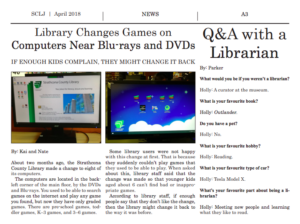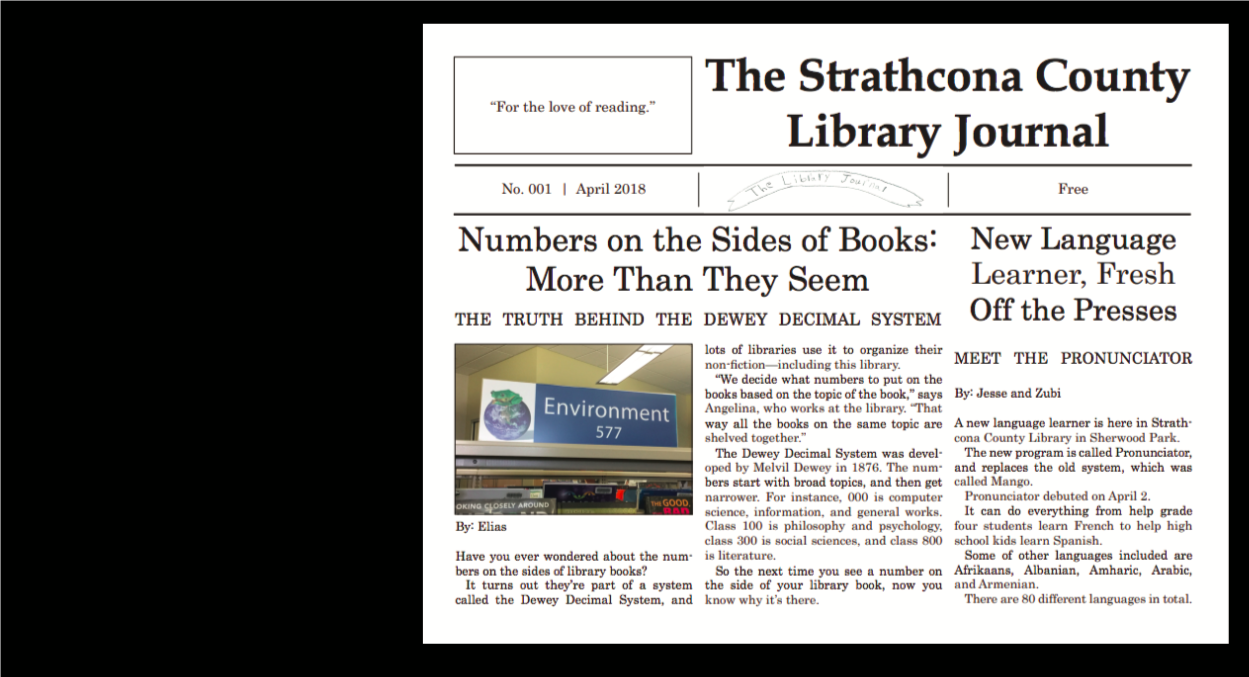This story was funded by the J-Source Patreon campaign.
When reporter Bridget Gutteridge-Hingston noticed library plants with “bone dry” soil, she knew she had her story.
“They looked like they hadn’t been watered in at least a few days,” said the 11-year-old reporter.
“I wanted to find out who was in charge of watering to make sure that wouldn’t happen again.”
Bridget’s resulting article was one of several in the Strathcona County Library Journal, a pop-up newspaper made by more than a dozen kids at an Alberta library over spring break.
The newspaper includes scoops like “The truth behind the Dewey Decimal System;” an “exclusive” look inside the library sorting room; and an op-ed arguing that libraries should give kids more time to borrow chapter books. There are also several book reviews, comics, and a hand-drawn word search.
“It was very run by us, not so much adults, which I hadn’t seen before,” said Bridget. “So it was really cool.”
Kids are natural journalists, said Michael Hingston, writer-in-residence for the Metro Edmonton Federation of Libraries. He ran the drop-in program and acted as editor-in-chief for the team of elementary school reporters, photographers, puzzle-makers and editors. While he expected the project would be fun, Hingston said, he wasn’t anticipating how much he’d learn about how differently kids see the world — and what happens when you give them the tools of journalism.
Children are curious, full of great questions and ideas, and see spaces from an entirely different perspective, said Hingston (who is also Bridget’s dad).
“They’re also very willing to go be nosy and ask questions that make adults uncomfortable sometimes.”
https://twitter.com/mhingston/status/984235589913329664
One girl, for instance, embarked on a classic “streeter,” asking people in the library about their favourite book. While pros tend to dread the streeter assignment, this fearless young reporter had dozens of answers in no time.
“It’s almost like kids are born with the tools to be great journalists, and then it kind of gets beaten out of them a little bit as they grow up,” said Hingston, who’d always been interested in how kids get into journalism. He wanted to show kids how much fun it can be, but also to emphasize all of the often-invisible jobs, people, responsibilities, checks and balances that go into producing accurate news.
“Not that this was the case, but I just think if kids are hearing messages like ‘oh the news is all made up’ … I wanted to show them that it’s actually taken incredibly seriously by the people who do it,” said Hingston.
“Even a little eight-page paper like ours took hours and hours of work, and I think they gained a respect for that process.”
At the beginning of the week, Hingston talked to the kids about what a newspaper is for, and the need for accuracy and believability. “Even on this level … I wanted to show them that you can’t just put anything you want in the newspaper.”
Part of the process was showing kids they can ask adults questions, or challenge the status quo.
One young reporter wanted to know why he could no longer play his favourite games on the computers — the library had changed the settings and limited which games kids could look up.
When he asked, staff told him they made the change so kids couldn’t look up inappropriate websites, but Hingston could tell he wasn’t satisfied. He suggested the boy go back and ask what it would take to reverse the decision.
The child was surprised: “I can ask her that?”
Turns out, if enough kids complain, the library would consider changing it back.

“Adults just dictate how things are to kids so much of the time,” said Hingston. “And one of the nice functions of this newspaper was to point out, well that’s the power of journalism. If the library made that decision for this reason, we’re going to put it in print and the readers can decide if that’s good enough or not.”
The kids could tell they were being entrusted with responsibility in making the newspaper, Hingston said. First and foremost he wanted it to be fun, but Hingston thinks kids came away from the experience feeling empowered.
In Bridget’s reporting, she learned that a staff member waters the plants once a week–but she didn’t think that was sufficient.
“I think they could be watered even more than that,” she writes in her article. “If you see a dry plant, water it!”
Bridget said she really liked reporting the story, and thinks it will lead to better-hydrated plants. She loved getting to choose what she wrote about; it’s a kind of freedom you don’t get at school.
“The whole premise was that it was all according to what the kids wanted to do, and I think when you give them the responsibility they really take to that,” said Hingston.
Hingston hopes others do their own version of this pop-up newspaper program. It’s an accessible project that doesn’t have to be based in a library, he says; all you need is a bunch of kids who have some time.
“If you ask them to look around and tell you what they’re interested in, you won’t have any shortage of material to draw from,” said Hingston.
Editor’s note, June 6, 2018, 5:22 p.m.: An earlier version of this story incorrectly spelled Bridget Gutteridge-Hingston’s name. We apologize for the error.
Laura Howells is a journalist and audio producer from St. John's now working in Toronto. Get in touch at laura.r.howells@gmail.com or say hi on Twitter.

